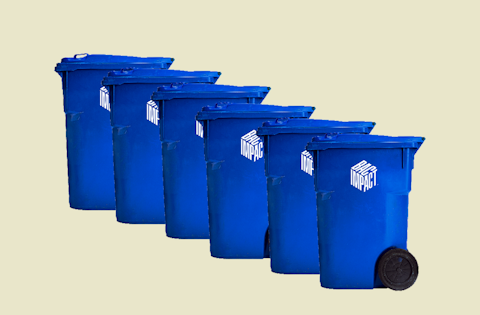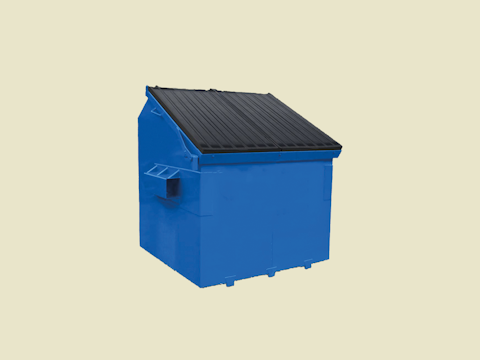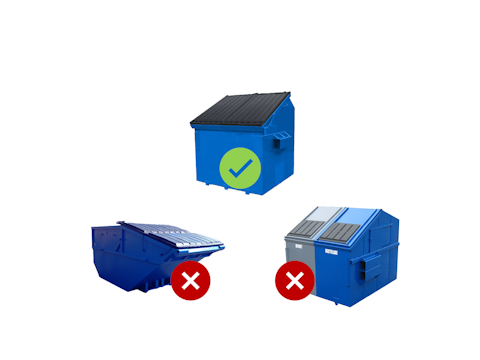As of January 1, 2026, the MRC of Brome-Missisquoi will manage a new regional contract for the collection and transportation of recyclable materials in containers for selected municipalities.
Did you receive a letter from your municipality about this?
If so, these changes apply to you.
What does the service include?

Distinctions for Industries, Businesses, and Institutions (IBI)
What is an assimilated IBI?
An IBI whose generation of recyclable materials is similar in type and quantity to a residential unit.
Maximum of six (6) 360 L wheeled bins, collected every two weeks.

What is a non-assimilated IBI?
An IBI that produces more than six (6) bins of recyclables every two weeks.
These are served using a container rather than wheeled bins.
Container costs
Éco Entreprises Québec (ÉEQ) sets the rules regarding container fees. Here is what applies:
- Some user types are eligible for free containers (rented by the transport company).
- Others must purchase or rent their own container to access the collection service.
| Users with no container fees (rented container) | Users who must provide their own container* |
|---|---|
Multi-unit buildings with 19 units or fewer | Multi-unit buildings with 20 units or more |
| Schools | Non-assimilated industries, businesses, and institutions (IBI) |
*Applies only if your building or IBI is currently served by municipal collection.
If not, these changes do not apply to you.

What type of container Is required?
To ensure efficient and compliant collection, only specific container types are accepted for recyclable materials.
Accepted Containers
- Front-loading containers only
- Sizes between 2 to 10 cubic yards
- Blue color is mandatory
Refused Containers
- Rear-loading containers
- Mixed-use containers (garbage and recycling combined)
Make sure your container meets these requirements to avoid service refusals.
How big should my building’s or business’s container be?
The number of dwelling units is a good starting point for assessing collection equipment needs. However, it should not be the only factor. Other elements must also be taken into account, such as:
-
The type of occupants (e.g., individuals, families), which influences the volume of materials generated
-
The type of building (e.g., multi-storey plex, row housing)
-
The available storage space
-
The accessibility of the collection area
Important Reminders:
-
Manage cardboard boxes efficiently (by flattening them)
-
Plan for 20% extra capacity beyond the estimated volume to account for seasonal variations and unexpected increases
-
Encourage shared use of containers between buildings to reduce the number of bins or containers, minimize clutter, and improve collection efficiency
Applies to residential buildings with 9 units or more.
| Number of units | Recommended container size (front-loading) |
|---|---|
| 9 to 12 units | 3–4 cubic yards |
| 13 to 19 units | 5–6 cubic yards |
| 20 to 30 units | 6–8 cubic yards |
| 31 to 40 units | 10 cubic yards |
| 41 units and more | To be assessed based on site-specific conditions. Special equipment (e.g., roll-off containers or compactors) may be allowed with ÉEQ approval. |
Rule of thumb:
1 cubic yard = equivalent to 2 x 360 L wheeled bins
FAQs for Multi-Unit Buildings
It is mandatory to have a recycling collection service.
In general, this type of building is serviced using wheeled bins.
However, depending on your municipality, your building may be serviced using a container instead.
Please inform your municipality of the following:
- Who owns the container (you, your municipality, or if it is rented from a private company)
- The size of the container to be collected
- If rented: the end date of your current contract, if applicable
Once your current rental contract ends, you will be integrated into the regional collection and transport service, and a container will be delivered to you free of charge.
It is mandatory to have a recycling collection service.
In general, these buildings are serviced with wheeled bins.
However, depending on your municipality, your building may be serviced with a container instead.
Please inform your municipality of the following:
- Who owns the container (you, or if it is rented from a private company)
- The size of the container to be collected
- If you rent a container: the end date of your current rental contract, if applicable
- If you have a collection and transport contract: the end date of that contract, if applicable
If you do not currently have a private contract, you will be integrated into the regional collection and transport service as of January 1, 2026.
If your current private contract ends after January 1, 2026, you will be integrated into the service once your contract expires.
If you currently rent a container, a new container will be delivered to you free of charge.
You must currently be serviced by your municipality in order to access this program. You will be integrated into the regional collection and transport service as of January 1, 2026.
Please inform your municipality of the following:
- Who owns the container (you, your municipality, or if it is rented from a private company)
- The size of the container to be collected
- If you rent a container: the end date of your current contract, if applicable
If you currently rent a container: a new container will be delivered to you free of charge.
You must currently be serviced by your municipality in order to access this program. You will be integrated into the regional collection and transport service as of January 1, 2026.
You will need to provide your own container, but collection and transport will be offered free of charge.
Please inform your municipality of the situation that will apply as of January 1, 2026:
- Who owns the container (you, your municipality, or if you will rent one from a private company)
- The size of the container to be collected
At this time, you are not affected by the regionalized service.
Here, the concept of building is what matters.
Are you part of an integrated development?
Your property assessment may indicate 18 units, but in reality, it’s made up of three separate buildings with six units each?
In that case, your building is considered to have six units.
You fall under the category of “multi-unit buildings with fewer than 8 units.”
FAQs for Industries, Businesses, and institutions (IBI)
You must currently be serviced by your municipality in order to access this program.
You will need to provide your own container, but collection and transport will be offered free of charge.
Please inform your municipality of the situation that will apply as of January 1, 2026:
- Who owns the container (you, your municipality, or if you will rent one from a private company)
- The size of the container to be collected
At this time, you are not affected by the regionalized service.
Your IBI generates more than six bins of recyclable materials (collection every two weeks), but you don't have space for a container.
Here are the options available to you:
- Check if it's possible to have a shared container with your neighboring businesses. You can thus share the purchase costs.
- As a last resort, it might be possible for your business to be collected using rolling bins. Your municipality must first accept this option and your business must assume the acquisition costs for the bins.
→ If your municipality currently offers a collection and transport service, you must join the regionalized service.
→ If your municipality does not offer a collection and transport service to IBIs, you are not concerned by the regionalized service.
However, as provided for in the Regulation on a selective collection system for certain residual materials:
- All institutions and businesses must have a service by 2027;
- All industries must have a service by 2030. The terms and conditions will be established by ÉEQ.
You are considered an ICI. You must then assess your needs and determine the quantity of materials you generate.
This will help determine whether you are an assimilable or non-assimilable ICI.
For more information, please contact your municipality.
Collection schedule
Find the recycling collection dates for your municipality here. A simple tool to make sure you never miss a pickup!
Available at the end of Fall 2025
